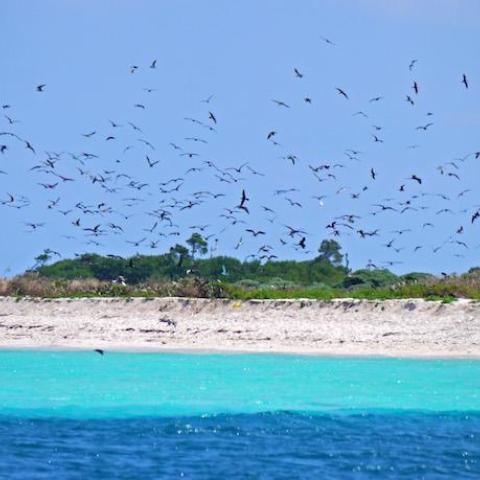
View of the staging area and campground from atop Fort Jefferson NPS Photo by S. Diaz
Dry Tortugas National Park in Florida has reopened the campground as scheduled after dredging the Fort Jefferson moat and redistributing sand that had built up from several hurricanes. For the safety of park visitors, the campground was closed for 45 days during the use of heavy construction equipment.
The next phase of the project involves dredging the finger piers to restore recreational and park access to the Garden Key waterfront. After the finger piers, the dredging will move to the moat near North Beach. During this time, the project will continue to use the area adjacent to the campground as a staging area, which may limit overflow camping.
The dredging work is part of a larger project to restore water flow in the moat and repair Fort Jefferson’s counterscarp (moat wall) damaged by Hurricane Irma in 2017 and Hurricane Ian in 2022. The final phase of the project will repair breaches in the moat wall and strengthen the existing counterscarp. The entire project is scheduled for completion by fall 2024.
Construction activity may continue to cause noise and visual impacts for day trip visitors traveling by seaplane, ferry and private boat. The park is working closely with the contractor to ensure maximum safe access to Garden Key and Fort Jefferson for all visitors.
The proposed repairs and dredging are supported by construction funds allocated through Public Law 115-123 for national park units impacted by Hurricanes Harvey, Irma and Maria.
Dry Tortugas National Park is located about 70 miles west of Key West and encompasses seven keys, collectively known as the Dry Tortugas. Fort Jefferson, a 19th century American masonry coastal fort, was constructed in 1846 to protect shipping access to the Gulf of Mexico. Garden Key, where the fort is located, is the primary destination for people visiting the park. The 14-acre island is home to the park’s visitor center, administrative areas, docking and mooring, campground and beaches.



 Support Essential Coverage of Essential Places
Support Essential Coverage of Essential Places







Add comment